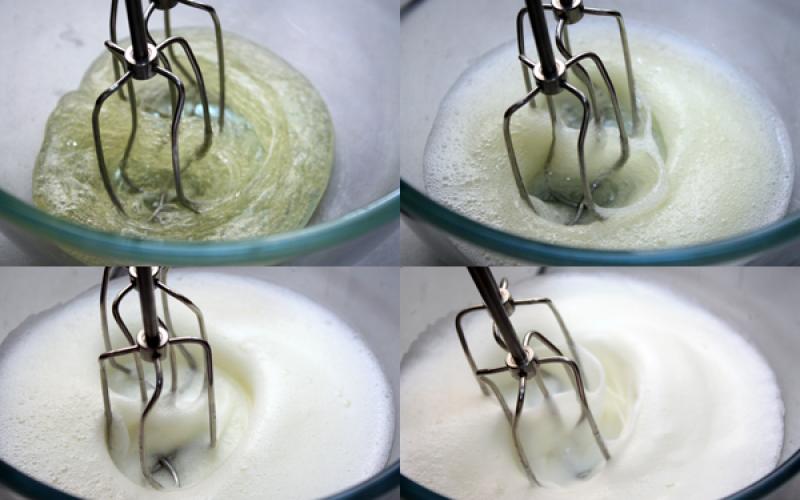It is well known that dairy products are extremely useful. Cottage cheese is their bright representative.
Regular consumption of cottage cheese increases the tone of the body, positively affects the digestive system and even strengthens the immune system.
Curd is a nutritional value.
Cottage cheese surpasses all dairy products in terms of protein content and the degree of its absorption. Therefore, cottage cheese can be safely attributed to the sources of proteins. The proteins in the composition of cottage cheese are easily broken down into their constituent parts - amino acids: tryptophan, methionine and others necessary for the human body.
In addition to essential amino acids, cottage cheese is rich in vitamins (especially A, E, P, B2, B6 and B12), folic acid, salts of calcium, iron, sodium, magnesium, copper, zinc, fluorine and phosphorus.
The colossal content of calcium in cottage cheese makes it indispensable for nutrition. The fat that is present in it can be removed during processing, so cottage cheese can be of varying degrees of fat content: from fatty to fat-free in general. Cottage cheese is considered fat, the fat content of which is higher than 5%. If it is lower, then the cottage cheese is called low-fat or fat-free. However, it should be remembered that in the absence of fat in cottage cheese, the absorption of calcium and fat-soluble vitamins is significantly reduced. Therefore, you need to choose cottage cheese with a moderate amount of fat - from 2 to 5%.
For an adult, it is considered normal to eat about 100 grams three times a week, because cottage cheese is a fairly highly concentrated product.
Interestingly, cottage cheese should be included in the diet of those people who want to normalize body weight, because with sufficient intake of calcium in the body, the process of weight loss is much more successful.
Cottage cheese in baby food.
 Children's cottage cheese is obtained by very specific methods. Firstly, this is done under aseptic conditions, that is, the access of bacteria is excluded. Access of air in the process is also excluded. Sourdough, which is used for the production of children's cottage cheese, is devoid of pathogenic microbes. The milk is filtered through specific membranes that retain the necessary proteins and calcium, while the rest is removed. There is one more important detail: calcium, which is so necessary for babies, is contained in this children's cottage cheese in an ionized form. This increases its absorption by the child's body. Also, such cottage cheese is useful for women after 40 years for the prevention of osteoporosis - a decrease in bone density.
Children's cottage cheese is obtained by very specific methods. Firstly, this is done under aseptic conditions, that is, the access of bacteria is excluded. Access of air in the process is also excluded. Sourdough, which is used for the production of children's cottage cheese, is devoid of pathogenic microbes. The milk is filtered through specific membranes that retain the necessary proteins and calcium, while the rest is removed. There is one more important detail: calcium, which is so necessary for babies, is contained in this children's cottage cheese in an ionized form. This increases its absorption by the child's body. Also, such cottage cheese is useful for women after 40 years for the prevention of osteoporosis - a decrease in bone density.
Cottage cheese or glazed curds.
But glazed curd cheeses - a favorite delicacy of children, it is better to exclude from the diet. A large amount of sugar, fat, additives, preservatives, flavor enhancers level useful composition the curd itself. Frequent use of glazed curds leads to increased weight gain, and the benefits of their use become minimal.
Be careful!
It should also be remembered that at present, to reduce the cost of cottage cheese production, vegetable hydrogenated fat (trans fat) can be added, which has an extremely negative effect on the human body. Therefore, be sure to read the labels, where it is written what each specific product consists of. In addition, now there is an excellent opportunity to cook cottage cheese yourself from milk and the corresponding sourdough.
Be healthy!
Cottage cheese is “solid milk”, a traditional sour-milk dish that has a high value for human health. It is obtained by removing whey from fermented milk. In some countries, it is considered to be a variety of soft young cheese, and they really have a lot in common. In Russian culture, cottage cheese is a separate product, revered for healing properties and high nutritional value.
According to the way the product is produced
The production of the product is carried out in two main ways: traditional and separate. Traditional production allows you to get two types of cottage cheese:
- Acidic, usually prepared from skimmed milk by adding starter cultures to it. Formed by the action of lactic acid.
- Acid-rennet is obtained by using rennet or pepsin to coagulate milk protein together with cultures of lactic acid bacteria.
The separate method of production is that the purified milk is separated into skimmed milk and cream with a fat content of 50-55%. The acid-rennet coagulation process produces a fat-free curd from the milk, which is then cooled and mixed with cream. With this method, you can get a product with any fat content, for example, soft dietary and peasant cottage cheese.
Types of cottage cheese with different properties
On the basis of the content of lipids in the product, it is divided into four categories:
- fat-free (up to 1.8%);
- lean or bold (2-3.8%);
- classic (4-18%);
- fatty (19-23%).
Cottage cheese is prepared using cream and table salt. The addition of consistency stabilizers is not allowed; rennet gives hardness to large grains. It is added to pasteurized milk, previously fermented with lactic acid streptococci, together with calcium chloride.

Diet cottage cheese is obtained by adding a solution to skim milk citric acid, calcium chloride and sourdough. To obtain table curd, a mixture of buttermilk and skim milk is fermented with a pure culture of lactic acid streptococci. The product can also have additives (raisins, candied fruits, nuts, dried fruits, chocolate), be produced in the form of a sweet mass, curds, creams and cakes.
Obtaining calcined cottage cheese involves adding a 10% solution of calcium chloride to fermented milk, which makes it possible to artificially increase the proportion of the mineral in the product and, accordingly, the benefits of cottage cheese for the human skeleton. It has a uniform texture and relatively bland taste due to low acidity.
A warning: Daily rate consumption of the calcined product should not exceed 100 g for an adult, large doses can harm the body. Its introduction into the children's diet must be agreed with the pediatrician.
Product types by origin
The origin of the product is determined by the type of animal from which the milk for fermentation is obtained. The most popular is cow curd cheese, in second place is goat, other varieties are much less common. Delicious, unusual and very useful cottage cheese made from sheep's milk.

Albumin curd
A special kind of product is albumin curd. It is produced from whey, its main protein is not casein, like any "regular" cottage cheese, but albumin, whey protein. It goes well with fruits, herbs, and is widely used for the production of confectionery.
Homemade cottage cheese
The benefits of homemade cottage cheese and its taste are difficult to overestimate. It is fresh, natural, free of stabilizers and other foreign substances. It can be purchased from small private farms, or you can make your own from raw or pasteurized milk.
Homemade cottage cheese recipe
Pour fresh whole milk into an enamel pan and put in a dark place to souring (the process takes about 24 hours). Heat yogurt in a water bath until whey separates and curd clots appear, let it cool. Throw the resulting mass into a colander or hang it in a gauze bag to drain the liquid.
Video: Homemade cottage cheese recipe
Useful properties and contraindications
Cottage cheese brings great benefits as a source of complete protein, which is easily absorbed by the human body. It requires significantly less effort from the digestive system than whole milk or curdled milk. The dish is used as part of diets in the treatment of obesity, heart disease, atherosclerosis, hypertension, disorders of the stomach, liver, kidneys, and pulmonary tuberculosis.
Athletes to recruit muscle mass cottage cheese diets are shown, especially during intense training. The product has a beneficial effect on the metabolism of fats, produces a diuretic effect. Regular nutrition of cottage cheese for 6 months helps to increase the amount of testosterone in men by 50%.
Curd calcium is indispensable for children during periods of active growth and formation of teeth and bones, for the elderly - in order to prevent osteoporosis. It is well processed by the body. The product also promotes the synthesis of hemoglobin and the restoration of the nervous system.
The benefits of albumin curd for the body is to maintain immunity and stimulate metabolism, cleanse the bile ducts and restore liver tissue. It improves vision, removes cholesterol, improves the quality of milk of nursing mothers, is useful for pregnant women, diabetics.
Video: "Live great!": Elena Malysheva's opinion on the benefits of cottage cheese
The use of cottage cheese for weight loss
Cottage cheese, especially albumin, is indispensable for overweight people. It helps to remove excess fluid from the body, speed up metabolism. A large amount of protein in the product makes it easy to satisfy hunger, maintain and build muscle tissue, while getting rid of fat.
A warning: For weight loss, you should use a product with a fat content of no more than 5%, otherwise it will not bring the expected benefits.
Recipe for a high-protein dish "Belip" ("without lipids")
Compound:
Cod (skinless fillet)
Low-fat cottage cheese without salt
Onion
Raw egg white
Cooking:
Mix cod, cottage cheese and onion in equal proportions and pass through a meat grinder, add protein raw egg, from the resulting mixture, prepare meatballs or a casserole.
Contraindications to the use of cottage cheese
Cottage cheese is harmful to health in case of an allergy to its components or individual intolerance to the product. With caution, include it in the menu for kidney diseases, avoid excesses. Regular consumption of cottage cheese somewhat lowers the level of serotonin in the brain. You can compensate for it with dates, bananas, soy and lentils, eggs and tomatoes.

Cottage cheese: rules for choosing and storing a product
Fresh cottage cheese usually has a slightly smearing, crumbly and soft texture. Whey may be present in a small amount, milk protein particles of different diameters are found. The taste and smell should be clean, characteristic of fermented milk products, and the color should be uniformly white, with a slight creamy tint.
A slight bitterness of the product is acceptable, especially in winter, a taste of wood. Attention should be drawn to signs that indicate damage to the product or a violation of the technological process of its production and that can harm the human body:
- A musty, unclean smell and taste is evidence of the work of putrefactive bacteria that have multiplied as a result of violations of the rules for storage, production regime or the use of inactive starter.
- Too sour taste is the result of lactic acid fermentation, the reasons for it may be insufficient and untimely cooling, excessively long pressing, the content of disinfectants or detergents, antibiotics in milk.
- The smell and taste of vinegar arises from the activity of acetic acid bacteria, is a consequence of the storage of the product at elevated temperatures.
- Rancid taste means the presence of mold and microorganisms in the food, which can occur with fatty cottage cheese when the pasteurization temperature of milk is insufficient.
- A bitter tint is a clear sign that the cow was fed grass or hay of a peculiar taste (wormwood), it can also indicate the presence of putrefactive bacteria, elevated content pepsin.
- Yeast taste, "swelling" of the lid of the container or pack are the consequences of the action of yeast during long-term storage of an insufficiently chilled product. Escherichia coli can also be the cause of swelling.
- The consistency of the “rubber” of grained cottage cheese suggests the introduction of an excess dose of rennet during its production or fermentation of milk at an elevated temperature.
- A large amount of whey is released from the cottage cheese with insufficient pressing.
- Mold and slime in the product appears as a result of its storage in dampness and loose packaging.
- The insipid taste of cottage cheese is due to the use of low-active sourdough.

Long-term storage of cottage cheese is impossible even at a low temperature of 0-2°C. Frozen, it can be stored for 6-7 months at a constant temperature of -18°C.
At a temperature of 2-6°C in the refrigerator, cottage cheese and curd products are stored for 36 hours, for a low-fat product with stabilizers, the shelf life is 7 days, heat-treated - 2 weeks. Increasing the shelf life in this case reduces its benefits to the body.
Advice: If the quality of cottage cheese has deteriorated during storage or freezing, it can be improved by mixing with cream. Soaking it in milk for 2 hours, followed by squeezing, also helps to refine the product.
The composition of the product
Cottage cheese is rich in micro and macro elements, contains some vitamins and a lot of protein. Depending on the fat content, the composition of the product varies, as does its calorie content. The energy value of cottage cheese 0.6% is 88 kcal, soft dietary 4% - 136 kcal, 9% - 169 kcal, 18% - 232 kcal.

Fatty types of cottage cheese are rich in vitamins A, E, but contain less B vitamins than low-fat varieties. Calcium and phosphorus in a fat-free product are slightly less, and the amount of other mineral salts also slightly differs.
Nutritional value of low-fat cottage cheese 0.6% (per 100 g of product)Curd - sour milk product, consisting of easily digestible calcium and growth. It is extremely important for children and the elderly, for people with tuberculosis, diseases of the bones, stomach, liver, kidneys.
How cottage cheese appeared
According to ancient records, mankind has been making cottage cheese for more than 4,000 years. Today it is impossible to say with certainty who and when made the first serving of cheese. Most likely, this product was “born” by accident. In principle, an ancient Eastern legend also talks about this. According to legend, an Arabian merchant, setting off on a journey through the desert, took with him a supply of milk. He kept the milk drink in a bag made from the stomach of a sheep. The rennet from the walls of the bag and the scorching sun did their job - the milk separated into whey and a thick sediment. In the evening, the Arabian found that the whey formed perfectly quenches his thirst, and the white thick substance with a delicious aroma is suitable as a nutritious product. The merchant made the next portion of cottage cheese already consciously. Further, the legend says that travelers from Asia passed the art of cheese making to Europeans. And since then, mankind began to mass-produce cottage cheese and other types of cheese.
Neolithic cheese?
But still, not so long ago, scientists made a discovery that casts doubt on the veracity of the legend. The thing is that in Poland, archaeologists discovered ceramic gratings, which are about 7500 years old. “Well, what does cottage cheese have to do with it?”, You ask. And despite the fact that researchers from the University of Bristol found on this ancient find a large number of milk fat residues. This led scientists to the idea that ceramic products were used by ancient people for the preparation or storage of dairy food. After a more detailed study of the find, the researchers suggested that these same gratings were once used to separate curds from whey.
According to archaeologists, cottage cheese was an extremely important product for the Neolithic people. Considering that almost the entire adult population at that time suffered from intolerance, then the ancients could use the fermented product without problems, saturating the body with nutrients from milk.
Presumably, in ancient times, people made more liquid cottage cheese. Part of it was eaten immediately, and the remains in clay pots were buried in the ground and fed on the product in winter.
Curd in Ancient Russia
 It is known that curd was also cooked in Ancient Rome, India and Russia. In Rome, this type of cheese was revered by both the poor and the rich. In ancient times, people used this product with milk, honey and wine. But the Hindus believed that cottage cheese is the favorite food of the god Krishna, which gives strength and cures diseases. Therefore, there is nothing strange in the fact that this lactic acid product was part of many ancient rituals in India.
It is known that curd was also cooked in Ancient Rome, India and Russia. In Rome, this type of cheese was revered by both the poor and the rich. In ancient times, people used this product with milk, honey and wine. But the Hindus believed that cottage cheese is the favorite food of the god Krishna, which gives strength and cures diseases. Therefore, there is nothing strange in the fact that this lactic acid product was part of many ancient rituals in India.
Russians made cottage cheese from curdled milk. The pots of drink were kept in the oven for several hours, then the contents were poured into cone-shaped linen bags and pressed down with a press. If our ancestors wanted to extend the life of the product, then several times they put the strained cottage cheese in a pot and sent it to the oven. The procedure was repeated until the cheese (namely, as cottage cheese was called in Russia) dried out completely. Then it was poured with melted butter and put into the cellar in earthenware. So the cottage cheese could be preserved for several months. By the way, in those days, drier cheese was more expensive.
Types of cottage cheese
Depending on the method of manufacture, it can be of several types:

By fat content, cottage cheese happens:
- fatty: 19 to 23%;
- bold (classic): 4 to 18%;
- lean: 2 to 3.8%;
- fat free: less than 1.8%.
Role in the body
Many of us understand that cottage cheese is good for health. But what exactly does this product do when it enters the human body? What role does he take on? Now let's try to figure it out.
Digestion
One of the main benefits of cottage cheese is the benefits for digestion.
Some studies have shown that it is able to treat infectious diseases of the stomach. In addition, it is important to remember that all lactic acid products have a beneficial effect on the intestinal microflora, on which, without exaggeration, the state of the whole organism depends.
Immunity
Healthy intestinal microflora is a guarantee of strong immunity. Cottage cheese is one of the best sources of probiotics. Daily consumption of this product helps the body fight harmful fungi, including the Candida genus, strengthens the immune system and restores healthy microflora.
 Bones and teeth
Bones and teeth
Like other dairy products, cottage cheese contains calcium, which plays a key role in strengthening bone tissue and tooth enamel. Phosphorus is also an important component of cheese. In combination with calcium, it promotes proper bone growth, which is especially important for children and adults after fractures. Regular consumption of this product prevents arthritis and osteoporosis.
Dandruff
Have you already tried all known methods to get rid of dandruff? It's time to try the cottage cheese. Dandruff is a fungal infection, and the fermented milk product has antifungal properties. Do you want to speed up your treatment? Then, in addition to eating, sour-milk cheese can be used as a mask for the scalp. Usually 1-2 procedures are enough to get rid of the problem.
stress and anxiety
Disorders of the nervous system are already a common component of the life of a modern person. But depression and stress have an extremely negative impact on the functioning of the whole organism. And here cottage cheese also comes to the rescue. The whole secret is that the composition of the product contains substances that affect the areas of the brain responsible for emotional stress.
Excess weight
As already noted, cottage cheese contains significant reserves of calcium. And it, in turn, is extremely important for the production of the hormone cortisol in the body, the lack of which leads to obesity and hypertension. Would you like to lose weight? To do this, it is enough to eat about 500 g of cottage cheese daily. For this purpose, there is a special curd diet, the effectiveness of which has been tested by many losing weight.
Vessels and heart
The presence of cottage cheese in the daily diet can reduce the risk of coronary heart disease, regulate and strengthen blood vessels.
Leather
Cottage cheese is able to replace a whole arsenal of cosmetic products for the skin. To improve the color and texture of the epidermis, it is important to eat at least a small portion of sour-milk cheese every day. It is a source of vitamin E, zinc, phosphorus and other substances important for the skin.
You can also use a face mask. Mixing some cottage cheese, flour and lemon juice, in just 15 minutes, you can restore radiance and softness to the skin.
Milk replacer
One of the important benefits of cottage cheese is that people who are intolerant to milk can side effects consume cheese and get the beneficial components contained in dairy products.
reproductive system
Some studies have shown that regular consumption of curd products affects the health of the reproductive system. Also, this product has the properties of an aphrodisiac, enhances libido and potency in men.
 Curd Benefits:
Curd Benefits:
- regulates blood pressure;
- lowers cholesterol levels;
- useful for fungal infections;
- effective for intestinal disorders;
- an important source of calcium;
- strengthens bones and tooth enamel;
- protects against cardiac disorders;
- reduces the risk of developing cancer.
- stimulates the immune system;
- relieves stress and anxiety;
- improves digestion;
- relieves hangover;
- provides energy;
- stimulates the brain and its functions.
Skin Benefits:
- promotes exfoliation of dead cells of the epidermis;
- gives freshness and radiance;
- makes the skin smooth;
- natural skin softener.
Hair Benefits:
- excellent product for dry and damaged hair;
- has the properties of an air conditioner;
- stimulates hair growth.
Side effects
Cottage cheese causes side effects very rarely, even in people with lactose intolerance. But still, organisms that are extremely sensitive to lactocomponents can react to this product with abdominal pain, constipation, diarrhea, and bloating. Allergic reactions are also possible in the form of skin rashes, shortness of breath, swelling, itching.
pure protein
Looking for a product that will provide the highest amount of protein possible? Consider what you have already found. To prepare a protein-rich dish, or more precisely, protein in almost “pure form”, you will need cod (fillet), low-fat cottage cheese, raw protein chicken egg and some onions. Pass all the ingredients through a meat grinder, mix, form meatballs or bake a casserole.
This dish is ideal for bodybuilders and people on a protein diet.
Cottage cheese: how to choose the right one?
 When choosing cottage cheese, it is important to pay attention to:
When choosing cottage cheese, it is important to pay attention to:
- consistency;
- Colour;
- smell;
- taste;
- fat content;
- preparation method.
Fresh product, as a rule, crumbly, soft, spreadable, with a fresh smell and natural sour-milk taste. Low-fat varieties have a small amount of whey. Properly cooked cottage cheese usually white color with a creamy finish.
By the way, a product made by the acid-rennet method (grain) is digested a little longer than other types of cottage cheese. This is due to the increased viscosity of the cheese.
What's wrong with cottage cheese?
Sometimes you can find that seemingly fresh cottage cheese has an uncharacteristic taste or smell. These hints will help you understand what is wrong with the product.
- Smell and taste of old.
It says that putrefactive bacteria have appeared in the product as a result of improper storage of cheese, non-compliance with production techniques or the use of bad sourdough.
- Vinegar notes.
This uncharacteristic taste and smell for cottage cheese is caused by acetic bacterium. Appears when the product is kept warm.
- bitterness.
Harmful bacteria and molds can grow in fatty curds, causing a bitter taste. The reason is non-compliance with production techniques. More precisely, during pasteurization, the milk was not heated enough.
Another very common cause of bitter curd is cow food. If the cattle ate bitter herbs, this would affect the quality of the milk, and then the quality of the cheese.
- Too sour.
Excessive pressing of the product, incorrect (insufficient, untimely) cooling, the presence of antibiotics in milk or "chemistry" in the finished curd manifest themselves as an excessively sour taste.
- Yeast flavor.
The composition of cottage cheese can get from or leaven for it. As a result (especially if the cottage cheese is kept warm), the fungus begins to actively grow and declare itself with a characteristic aftertaste.

The insipid product, devoid of the characteristic curd taste, indicates that a weakly active sourdough was used for its manufacture.
- Too wet.
The reason is insufficient decantation and squeezing of the curd mass.
- "Rubber" cottage cheese.
This effect can occur for two reasons. If too much rennet was used in the manufacture of the product or the milk was fermented at too high a temperature.
- and mold.
It must be said right away that such a defect is dangerous to health. Appears if the product was stored in a damp room and without compliance with the rules.
How to cook yourself
 A variation of cottage cheese from supermarkets is homemade cheese, which can always be bought on the market. But it is precisely this version of the product, as nutritionists say, that can be fraught with the most dangers if it is made from low-quality milk.
A variation of cottage cheese from supermarkets is homemade cheese, which can always be bought on the market. But it is precisely this version of the product, as nutritionists say, that can be fraught with the most dangers if it is made from low-quality milk.
For greater confidence in the freshness and quality of the product, you can try to cook cottage cheese yourself. Moreover, there is nothing complicated in this recipe.
For cooking homemade cheese you will need yogurt, which must be placed for some time on water bath. When a protein lump forms in the liquid, drain the whey and place the cheese lump in a gauze or cloth bag. Press down with weight. When the excess liquid leaves, the cottage cheese is ready for use. Such a product, of course, will appeal to adults and children. But, most importantly, now you are confident in the quality and freshness of your cheese.
The finished product can be eaten without additives, with vegetables, fruits, sour cream or yogurt, added to salads, cooked from it cheesecakes, pies and pies, cookies, cheesecakes and desserts. In a word, everything that fantasy allows.
How to store
Curd is not intended for long-term storage. The manufacturer indicates safe terms on the packaging. Thermally processed cottage cheese retains its freshness the longest (up to 2 weeks). A product with stabilizers will “last” up to a week. And no longer than 36 hours live 18 percent and fat-free varieties, as well as curd products.
You can extend the life of cottage cheese up to several months if you freeze it. At the same time, it is important to maintain a stable temperature in the freezer. Any hesitation will make the cheese dry and with chunks of ice. You can restore tenderness to defrosted cottage cheese if you mix it with 50% cream or pour milk for 2 hours in a one-to-one ratio.
Curd is a unique product. It tastes equally savory and sweet. It is a nutritious food, which, however, promotes weight loss. And what is most interesting, being a dairy product, it is suitable for people with lactose intolerance. Scientists are still arguing about the age of cottage cheese, and the best chefs in the world compete in cooking skills. delicious food from fermented milk cheese - an almost ideal product in terms of its properties.
When exactly people first extracted cottage cheese from milk and tasted its amazing taste, there is no exact information, but ancient treatises tell us that our ancestors used this very tasty dairy product and even used the benefits of cottage cheese for medicinal purposes.
The food industry offers the consumer a wide range of cottage cheese and curd products. Cottage cheese is a fermented milk product and is obtained by fermenting whole milk and separating whey. The mass remaining after this process is the curd.
Cottage cheese is produced from various dairy raw materials, from natural milk and normalized, reconstituted and recombined, from a mix of dairy products. It is divided on the basis of fat content from 1.8 to 25% (there is also completely fat-free) and on the quality of raw materials. Milk for cottage cheese is used both pasteurized and whole.
The most useful outside of any classification is considered cottage cheese . It is made from curdled milk by heating in a water bath. The protein is separated from the whey and the curd mass in a gauze bag is put under pressure.
Composition and calories
The composition of cottage cheese contains many substances useful for the body:
minerals: phosphorus (27.5%), calcium (16.4%), potassium (4.5%), iron (2.2%), magnesium (5.8%), sodium (3.2%);
amino acids (choline and methionine);
vitamins of groups A (8.9%) and B (19.4%);
vitamin PP (15.9%);
casein is a unique milk protein;
lactic acid bacteria.
The energy value (calorie content) of cottage cheese is 155.3 kcal 100 g of the product contains 16.7 g of protein, 9 g of fat and 2 g of carbohydrates.
9 health benefits of cottage cheese
-
Replenishes the body with protein
Cottage cheese is an excellent source of protein, on average, 100 grams of this product contains from 14 to 18 percent of proteins. At the same time, unlike products of animal origin (meat, fish or poultry), the structure of cottage cheese does not consist of tissue fibers. Therefore, the body easily absorbs and digests curd flakes, receiving the necessary amount of protein - the most important component for the healthy development of all body tissues.
-
Strengthens bone tissue
Regular use of cottage cheese will allow you to forget about visits to traumatologists and dentists for a long time. Due to the high calcium content, cottage cheese strengthens bone tissue, minimizing the risk of bone fractures. In addition, by adding this healing product to your daily diet, you can strengthen your teeth and protect them from the development of caries.
-
Improves Liver Health
Cottage cheese contains the essential amino acid methionine, which is an excellent fat burner. It protects the liver from obesity, which can develop due to high cholesterol levels or negative impact on the liver of certain drugs or dangerous toxins. In addition, doctors recommend consuming at least 300 grams of cottage cheese daily for people who are undergoing antibiotic treatment.
-
The benefits of cottage cheese for women and children
Due to its rich composition, cottage cheese is extremely useful for pregnant women and nursing mothers. It replenishes the body with calcium and other micro and macro elements that a woman loses during pregnancy, and has a beneficial effect on the development of the fetus itself. Small children are recommended to give low-fat cottage cheese from the age of five to seven months. The product contributes to the growth and development of all tissues of the body, especially it is necessary for the formation of bones.
-
The benefits of cottage cheese for the elderly
Due to its high calcium content, regular consumption of cottage cheese protects the elderly from the development of osteoporosis, the main symptom of which is brittle bones, and also strengthens teeth. Iron in cottage cheese improves blood circulation, potassium and magnesium stabilize the work of the cardiovascular and nervous systems, and a complex of vitamins improves brain activity.
-
Improves digestion
Cottage cheese is included in the diet for people with various diseases gastrointestinal tract: peptic ulcer, gastritis, pancreatitis, etc. It is very easily digested and does not "load" the stomach, and the lactic acid bacteria contained in it improve intestinal motility. But for these purposes it is best to use non-acidic cottage cheese with a minimum fat content.
-
as a diuretic
Due to the presence of calcium salts in cottage cheese, it has a pronounced diuretic effect. Due to this, it is successfully used for the treatment of kidney diseases and hypertension. In addition, cottage cheese is used in dietary nutrition to remove excess fluid from the body, and those who want to lose a couple of extra pounds even arrange “curd” unloading days.
-
For healthy skin, hair and nails
Due to the beneficial properties of cottage cheese, its regular addition to the diet improves the condition of the skin, hair and nails. But in addition to eating, this healing product is also used at home in the form of masks for the face, décolleté, hands and scalp. It is also found in many skin and hair care products. In addition, curd compresses are successfully treated sunburn What home remedies and preparations will help relieve pain and heal sunburn. How to use the products, what to do and what to avoid in various stages of a burn. .
-
Cancer Prevention
Scientific studies have shown that eating cottage cheese prevents the occurrence of cancer. Due to the rapid saturation of the body with calcium, cottage cheese helps to eliminate free radicals, which are the main cause of cancer. In addition, this fermented milk product promotes phagocytosis of cancer cells. What does this mean? The human immune system uses special cells called phagocytes that track down cancer cells and engulf them. After such absorption, the phagocyte must be neutralized. This is where cottage cheese comes in handy, which contributes to the breakdown of such a cell by active digestive enzymes.
The benefits and harms of fat-free cottage cheese
There is an opinion that fat-free cottage cheese is not as tasty and healthy as fat, and does not have the same set useful properties, since during degreasing, all the most valuable was removed from it. This opinion is wrong.
In its composition, low-fat cottage cheese is not inferior to fat. It contains the same vitamin group B, C and D, only vitamin A becomes less during degreasing, since it is fat-soluble and is excreted along with fat. Minerals in cottage cheese are preserved, only the percentage of fat content of the product decreases.
Fat-free cottage cheese brings the same benefits as other types of cheese. Calcium strengthens the skeletal system, potassium improves the functioning of the cardiovascular system, vitamins strengthen the immune system.
The only downside fat-free cottage cheese is that it has a low percentage of calcium absorption, but this in no way indicates the dangers of cottage cheese. Experts say that for normal absorption of calcium by the body, cottage cheese must be not less than 9% fat.
Fat-free cottage cheese can be harmful to the body only if a person is on a strict diet and eats only low-fat cottage cheese, without eating any other products.
Contraindications to the use of cottage cheese
Cottage cheese brings great benefits to human health, but due to ignorance and inattention of the consumer, it can also cause harm. There are some contraindications for the use of fat-free cottage cheese, below are some of them.
- Cottage cheese should be abandoned to people with individual intolerance to the product.
- Cottage cheese can harm the body if you use a product with an expired shelf life.
- In the industrial production of cottage cheese, various chemical additives can be included in its composition to increase the shelf life and improve taste, and they can be very harmful, so you need to choose cottage cheese with a minimum content of foreign substances.
- Natural cottage cheese, on the contrary, has a very short shelf life and should be used within two to three days and stored only in the refrigerator.
- An overdose of cottage cheese is also harmful, like any other product. Its excess can adversely affect the normal functioning of the kidneys.
Otherwise, there are no contraindications. You can use cottage cheese for all people at any age, but only fresh and in moderation.
Cottage cheese one of the oldest, most valuable and the most useful products, known to mankind. It is obtained by fermenting milk and removing (draining) the whey. Cottage cheese was made in ancient Rome. The Roman philosopher Columella, who lived more than two thousand years ago, spoke about cottage cheese: "Desirable food on the tables of both the poor and the rich". As for the ancient Slavs, cottage cheese was on their tables almost daily. Both Slavs and Europeans mixed cottage cheese with honey, wine or milk. They ate it both salted and not salted.
Cottage cheese is delicious with honey
Components of cottage cheese and its types
It is thanks to its components that cottage cheese is widely used in both children's and dietary nutrition. In addition to magnesium, phosphorus and iron, it contains calcium necessary for bones and vitamins that protect against atherosclerosis. Amino acid methionine protects our liver. The complete proteins contained in cottage cheese are absorbed by the body better and faster than dairy or fish meat proteins. Cottage cheese is rightly called a product that knows no prohibitions in clinical nutrition. So, cottage cheese is well absorbed by the body due to the association of protein with phosphorus and calcium salts. Minerals are involved not only in bone formation, but also in the nutrition of the nervous system and hemoglobin formation in the blood.

Variety of cottage cheese
Cottage cheese is not only fatty, semi-fat or low-fat. It can be fat-free, dietary and table. So is our food industry produces various curd masses, cheese curds with additives, curd creams and desserts, creamy and fruit curds of various degrees of fat content. In Japan, tofu is very popular soybean curd, in the production of which milk is not used.
Curd in cooking
Since cottage cheese is not only healthy, but also tasty, it occupies a worthy place among the ingredients of second courses and desserts. Cottage cheese is well stored at a temperature of + 8-10 degrees, but no more than two days. If there is a need for longer storage, then - in the refrigerator in an enamel bowl with a piece of sugar. But cottage cheese, which has been stored for more than two days, is recommended to be used only in the preparation of cheesecakes, casseroles or dumplings. Fatty cottage cheese makes excellent cheese. Most cottage cheese dishes are very easy to prepare and at the same time extremely tasty. If you buy cottage cheese and a jar of cod liver, you get an amazing pate. For 300 grams of cottage cheese (18% fat cottage cheese is better), you will need half a 125-gram jar of liver, about 100 grams of softened butter, a clove of garlic, salt and ground pepper. All ingredients must be mixed well.
Cottage cheese at home

gauze pouch
There are several ways to make cottage cheese at home. For example, from kefir. Kefir must be poured into an enameled bowl and placed in a basin with hot water. Put the pelvis on the most small fire and, stirring, wait until the yogurt curdles. Then throw the resulting mass into a colander lined with a double layer of gauze. When the bulk of the whey drains, tie a gauze bag with almost ready-made cottage cheese and hang this bag over the sink so that the remaining whey drains into it. You can also make cottage cheese from milk. Milk - boil, cool to 30 degrees and ferment with sour cream at the rate of 4 tablespoons per liter of milk. Fermented milk should stand in a warm place at least 7 hours. Then - the same procedure with gauze, as in the previous case.
You can cook not just cottage cheese, but medicinal, calcined. It is useful not only for teeth and bones, it also stabilizes the central nervous system and improves blood clotting. But you need to eat such cottage cheese without "fanaticism", no more than 100 grams per day! So, buy at any nearest pharmacy 10% solution of calcium chloride, and in the store - a liter of milk. Heat the milk on the stove and pour calcium chloride into it (a little more than two tablespoons per liter, in case of an overdose, the cottage cheese will be very bitter). Then, while stirring, bring the milk to a boil. It will curdle and you need to remove the pan from the heat and cool the milk. After that, get rid of the serum with a sieve or gauze.
Links
- Recipes with cottage cheese, women's social network myJulia.ru
- Cottage cheese: recipes, culinary portal Povarenok.ru








